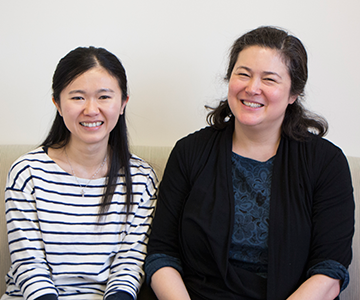Hui-Ting Hsu (l) and Susan Mango
Talk to any teenager and they will tell you the many ways they want to be independent from their parents. However, the tug for independence begins much earlier in life, in the embryo. At fertilization, the one-cell embryo carries RNA and protein donated by the mother, but over time, these factors are degraded, and the embryonic genome kicks into gear. This transition involves reorganization of DNA within the nucleus and the onset of embryonic transcription. A central question in developmental biology is how an embryo initiates its transcriptional program and coordinates transcriptional events in space and time.
Graduate student Hui-Ting Hsu examined these questions in a recent paper published in Science, along with her colleagues Mei Chen, Zungyoon Yang, Jie Wang, Nicholas Lee, Anat Burger, Ken Zaret, Tao Liu, Erel Levine and Susan Mango. They found that very young embryos have many genes that are transcriptionally quiescent but retain RNA polymerase at their transcription start sites (a state known as poised). With age, the embryo becomes transcriptionally active, and poised RNA polymerase begins to elongate. How is RNA polymerase directed to gene promoters and what controls the transition from poising to elongation? Hsu and colleagues addressed loading of poised RNA polymerase for the C. elegans foregut. They showed that the central transcriptional regulator of foregut identity (a protein called PHA-4) was required to recruit RNA polymerase to foregut target genes. PHA-4 belongs to a class of transcription factors known as pioneer factors, which are among the first factors to bind silent target genes and facilitate chromatin opening at promoters. Hsu and colleagues showed that RNA polymerase bound target promoters early in development – hours before the onset of transcription – and might promote chromatin opening in conjunction with PHA-4. The picture that emerges is that transcription during foregut development passes through three stages: i) early binding of pioneer factor PHA-4 and RNA polymerase; ii) opening of chromatin by one or both factors, to facilitate the loading of additional transcriptional factors; iii) conversion of RNA polymerase from a poised to an elongating form. Pioneer factors regulate transcription in many contexts and organisms, raising the possibility that recruitment of poised RNA polymerase by pioneer factors may be a conserved function in other settings.
Read more in Science or download PDF


